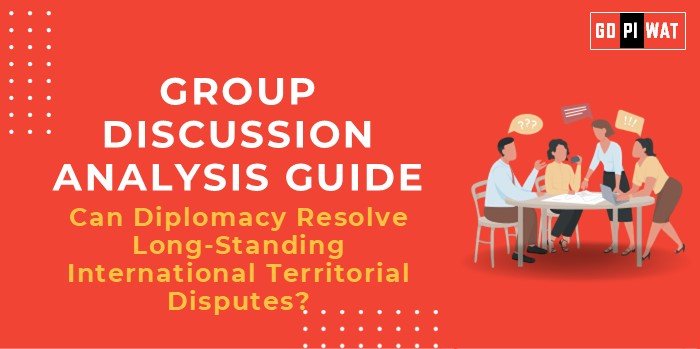📋 Group Discussion Analysis Guide: Can Diplomacy Resolve Long-Standing International Territorial Disputes?
🌐 Introduction to the Topic
Opening Context: Territorial disputes, such as those between India and China over the Line of Actual Control or Israel and Palestine over borders, remain among the most intractable global challenges. Their resolution, or lack thereof, often shapes international stability.
Topic Background: Many disputes arise from historical claims, colonial legacies, or strategic interests. The role of diplomacy in resolving these disputes is debated, with successes like the Camp David Accords contrasting unresolved conflicts like Kashmir.
📊 Quick Facts and Key Statistics
💰 Economic Cost: Border conflicts cost global trade approximately $50 billion annually (World Bank, 2023).
📈 Success Rate of Negotiations: Only 10% of disputes since 1945 have been fully resolved diplomatically (Peace Research Institute, Oslo).
🕊️ Recent Diplomatic Success: Ethiopia-Eritrea Peace Agreement (2018) ended a 20-year conflict.
🤝 Stakeholders and Their Roles
- 🏛️ Governments: Act as primary decision-makers, driven by sovereignty and public sentiment.
- 🌐 International Organizations: UN and ICJ facilitate negotiations and enforce resolutions.
- 🤝 Regional Alliances: Entities like ASEAN or the EU provide platforms for dialogue.
- 📢 Non-Governmental Organizations (NGOs): Promote grassroots peacebuilding.
- 🌍 Global Powers: Often mediate but can have conflicting interests.
🏆 Achievements and Challenges
✨ Achievements:
- 🤝 Ethiopia-Eritrea Peace Accord: Resolved decades-long conflict through mediation by Saudi Arabia and the UN.
- 🏴 Ireland-UK Good Friday Agreement: Ended sectarian violence in Northern Ireland.
- 🌐 Boundary Agreements: Successes between India-Bangladesh (2015) and Peru-Ecuador (1998).
⚠️ Challenges:
- 📣 Nationalism: Limits willingness to compromise.
- 📍 Geostrategic Importance: Disputes like the South China Sea involve global interests.
- 🔄 Protracted Nature: Disputes often span generations, fostering entrenched positions.
📚 Case Studies:
- 🌏 Kashmir: A frozen conflict with sporadic diplomatic talks but no resolution.
- 🌊 South China Sea: Ongoing disputes despite arbitration rulings.
🗣️ Structured Arguments for Discussion
Supporting Stance: “Diplomacy fosters dialogue and compromises, as seen in the Ethiopia-Eritrea Accord.”
Opposing Stance: “Historical animosities and nationalist policies often render diplomacy ineffective, as in the case of Kashmir.”
Balanced Perspective: “Diplomacy can resolve disputes with active international mediation, but sustained political will is critical.”
💡 Effective Discussion Approaches
- 📜 Opening Approaches:
- “Given that only 10% of territorial disputes since 1945 have been resolved diplomatically, the efficacy of diplomacy merits analysis.”
- “The Ethiopia-Eritrea Accord exemplifies the potential of diplomacy in resolving disputes, but its replicability is questionable.”
- 🛠️ Counter-Argument Handling:
- Acknowledge nationalism as a barrier but cite successful precedents.
- Present case studies highlighting external mediators’ effectiveness.
📈 Strategic Analysis of Strengths and Weaknesses
- 🏅 Strengths: Global institutions support diplomacy, avoids military escalation.
- ⚠️ Weaknesses: Slow and uncertain process, risk of biased mediators.
- 💡 Opportunities: Leveraging technology for transparency, inclusive negotiations involving stakeholders.
- ⚡ Threats: Renewed aggression if diplomacy fails.
🎓 Connecting with B-School Applications
- 📚 Real-World Applications: Study of conflict resolution strategies for leadership training, projects analyzing international negotiations.
- 💬 Sample Interview Questions:
- “What role can multilateral organizations play in resolving territorial disputes?”
- “Discuss how nationalism impacts the success of diplomatic resolutions.”
- 🔑 Insights for Students: Understanding geopolitical dynamics is crucial for global leadership. Case studies on diplomacy provide frameworks for conflict resolution.


